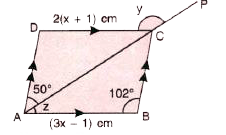Consider the following parallelograms. Find the values of the unknowns x, y, z.
To find the values of the unknowns x, y, and z in the given parallelogram, we can follow these steps:
Step 1: Understand the properties of a parallelogram
In a parallelogram, adjacent angles are supplementary, meaning they add up to 180∘. Also, opposite angles are equal.
Step 2: Identify the given angle
We are given that angle B is 100∘.
Step 3: Find angle A (which is z)
Using the property of supplementary angles:
Angle A+Angle B=180∘
Substituting the known value:
z+100∘=180∘
To find z, we subtract 100∘ from 180∘:
z=180∘−100∘=80∘
Step 4: Find angle C (which is x)
Since opposite angles in a parallelogram are equal:
Angle C=Angle A
Thus:
x=z=80∘
Step 5: Find angle D (which is y)
Again, using the property of opposite angles:
Angle D=Angle B
So:
y=100∘
Final Values
Now we have found:
- x=80∘
- y=100∘
- z=80∘
Summary
The values of the unknowns are:
- x=80∘
- y=100∘
- z=80∘
---
In a parallelogram, adjacent angles are supplementary, meaning they add up to 180∘. Also, opposite angles are equal.
We are given that angle B is 100∘.
Using the property of supplementary angles:
Angle A+Angle B=180∘
Substituting the known value:
z+100∘=180∘
To find z, we subtract 100∘ from 180∘:
z=180∘−100∘=80∘
Since opposite angles in a parallelogram are equal:
Angle C=Angle A
Thus:
x=z=80∘
Again, using the property of opposite angles:
Angle D=Angle B
So:
y=100∘
Now we have found:
- x=80∘
- y=100∘
- z=80∘
The values of the unknowns are:
- x=80∘
- y=100∘
- z=80∘
Topper's Solved these Questions
- UNDERSTANDING QUADRILATERALSBOOK - NCERT ENGLISHCHAPTER - UNDERSTANDING QUADRILATERALSEXERCISE - EXERCISE 3.2
6 Videos
- SQUARES AND SQUARE ROOTSBOOK - NCERT ENGLISHCHAPTER - SQUARES AND SQUARE ROOTSEXERCISE - EXERCISE 6.4
9 Videos
- VISUALISING SOLID SHAPESBOOK - NCERT ENGLISHCHAPTER - VISUALISING SOLID SHAPESEXERCISE - EXERCISE 10.3
8 Videos
Similar Questions
The following figures are parallelograms. Find the degree values of the unknowns x, y, z figure (ii) figure (iii) figure figure (v) figure (vi) figure
View SolutionFind the value of x, y and z
View SolutionFind the value of x, y and z
View SolutionFind the value of x,y and z.
View SolutionUse the information given in the following diagram to find the values of x, y and z.
 .
.
View SolutionIn the given figure, ABCD is a parallelogram. Find the values of x, y and z

View SolutionIn Fig 3.26, BEST is a parallelogram. Find the values x, y and z.
View SolutionIf the points (−2, −1), (1, 0), (x, 3) and (1, y) form a parallelogram, find the values of x and y .
View SolutionIn Figure, BEST is a parallelogram. Find the values of x, y and z.
View SolutionConsider the following graph:

X, Y and Z can be respectively
View Solution
